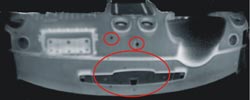
Posted to News on 12th Jun 2008, 17:21
How to use infrared to simplify inspection tasks
By applying a little lateral thinking, engineers can use infrared cameras for simple-to-deploy 'heat signature' quality assurance tasks that would otherwise be very challenging to implement using alternative inspection technologies.

Infrared cameras are now commonly used for on-line thermal imaging and machine vision applications. Engineers have recognised the advantages of being able to see thermal patterns in real time and using the infrared video output and embedded temperature measurement data to trigger alarms, steer processes and ensure quality.
Although infrared is not a new technology it is only relatively recently years that it has effectively been commercialised. Flir Systems is one of the architects of this change. Its thermal imaging products are now eminently affordable and, indeed, their cost is said to be inconsequential when considered alongside its huge savings potential. Lost production, product recalls and damage to a manufacturer's reputation can all have costly consequences.
Easy integration
An important development in the world of infrared is the ease with which it can be integrated into the production process. Until now it was a relatively time-consuming task but this has changed with the introduction of Flir Systems' new ThermoVision A320 cameras that are compatible with the standard protocols GigEVision and GenICam. This versatility also allows seamless integration with third-party hardware and software.
With modern cameras, data capture is in real time, which is an important factor in high-throughput environments. Radiometric values can be applied to alarms automatically so that any thermal inconsistency can be investigated.
Gigabit Ethernet interfaces on the cameras ensure that even over long distances a high-speed frame rate is achieved, with some models providing up to 60Hz of the full 16-bit image.
The need for stable product quality is why more manufacturers are investing in this technology. In the white goods industry, for example, Flir Systems' thermal imaging is widely used to provide an automatic quality check of fridges. It provides a complete picture of the working elements, enabling faulty coolant volumes, clogged hoses or leaking pipes, for example, to be immediately detected.
Automotive industry
In automotive production, thermal imaging has considerable potential. One example of this is Flir Systems' collaboration with systems integrator Automation Technology GmbH, where several Flir Systems ThermoVision A-Series cameras have been installed to optimise dashboard production.
A dashboard comprises three material layers one of which is foam. If air is trapped in this layer during production it can result in bulges and bubbles becoming visible when the installed dashboard is exposed to the heat of the sun. This potential has been eliminated thanks to the introduction of the thermal imaging-based DashboardCheck. By heating the dashboard and viewing it with an infrared camera, any air bubbles can be clearly identified because these areas will absorb heat - and then radiate it - differently (see image above).
Modern car seats also comprise layers of different materials. The basis for their production is a skeleton of steel struts that, at a later stage of production, is filled with foamed plastic. The low contrast between the glossy moulding material and the matt struts prevents traditional video imaging from being effective in inspecting the moulding process. However, this is no problem for Flir Systems' ThermoVision A-Series camera, as it uses differences in emissivity to determine the presence and correct positioning of the struts.
Medical application
A leading medical device manufacturer has also chosen to incorporate infrared to optimise the automated welding of its plastic fluid delivery systems. Special-purpose machines undertake the full production process from cutting and sealing the non-PVC bag, to attaching dispensing tubes by means of welding.
Naturally the seal quality is critical and needs to be uniform on all seams. Creating this uniformity is dependant on a constant temperature being maintained in the machines' heating elements and the even distribution of heat during the sealing process. Thermocouples had been used to provide thermal feedback but these provided only spot measurements and did not show the temperature distribution along the entire length of the weld.
The solution to the problem was provided by a Flir Systems infrared camera. Placed inside the machine with a clear view of the bags emerging from the mould, it provides continuous, non-contact measurement of the heat distribution at the seal at an image frequency of 60Hz.
Thermal imaging has emerged as a highly valuable tool in all phases in the life of a manufactured product from prototype testing, through production and into service. But the potential of the technology does not stop there. It can also play an important role in the early detection of fire and provide important, even life-saving, information as it can see through smoke.
This is a highly versatile technology whose scope grows daily and one that, in most cases, delivers an exceptionally quick return on investment.
For more information about Flir Systems' ThermoVision A320 cameras, visit www.flir.com/thg.
Want the latest machine building news straight to your inbox? Become a MachineBuilding member for free today >>

















